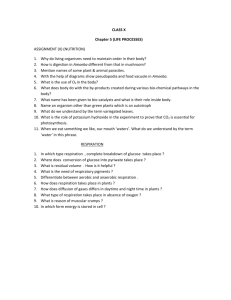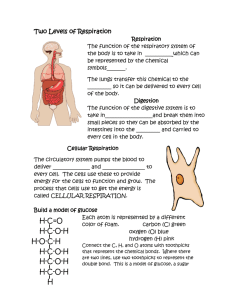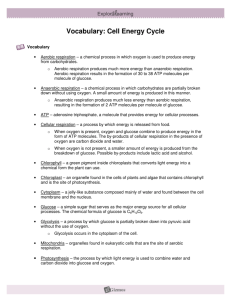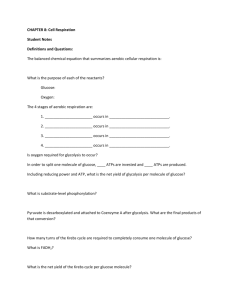Respiration National 4 class materials pdf
advertisement
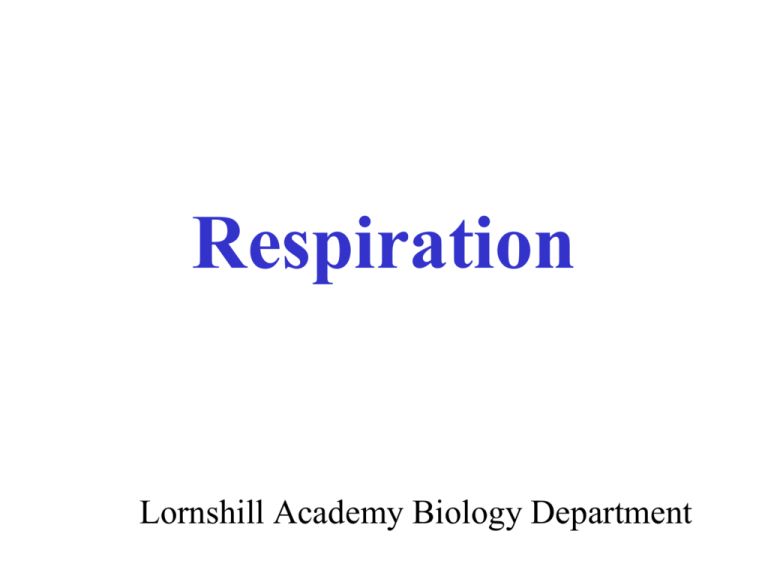
Respiration Lornshill Academy Biology Department Respiration is defined as “the controlled release of energy from food molecules within cells” Animals eat food as a source of energy. This food is then digested by enzymes into small, soluble molecules which can be transported into cells. The cell then releases energy from these molecules by respiration. Is the invisible man in this room? Is there any energy in this peanut? Comparing energy contents of different food types thermometer Boiling tube 5 ml water food spike Variable changed Variables the same Type of food Volume of water Starting temperature Weight of food Distance food - water These have to be kept the same to make the comparison fair Results Type of food Peanut (fat) Wotsit (carbohydrate) Egg white (protein) Starting Final Temperature temperature temperature rise Degrees C Degrees C Degrees C Conclusion – _____________ and ______________ contained much more energy than ____________. ‘identify sources of error in experimental design and suggest improvements’ Sources of error - Suggested improvements - ‘identify sources of error in experimental design and suggest improvements’ Sources of error Food not completely burned Heat escapes up the side of the tube Suggested improvements Re-ignite food or add oxygen Use flat bottomed tube or beaker Food molecules do not contain the same amount of energy. •Fats contain most energy •Carbohydrates are also good energy sources •Proteins contain very little energy - their main importance is as body building materials. Cells use the energy they release from foods for a variety of purposes •movement - e.g. muscle cells •division - e.g. bone marrow cells •heat production - e.g. liver cells •building products (synthesis reactions) e.g. liver cells, cells making digestive enzymes The overall equation for respiration is - glucose + oxygen (raw materials) CO2 + water + ENERGY (products) CO2 (waste water products) There are a series of standard experiments to show that each of the materials is actually involved in the process of respiration. How can you show that CO2 is produced ? How can you show that oxygen is used up ? How can you show energy is produced ? A demonstration will be set up to demonstrate that energy is produced during respiration. Germinating seeds Dead seeds Two flasks are set up; one with germinating seeds, the other with dead seeds. The dead seeds are a control. They are not respiring, so they give a result to compare the respiring seeds with. Germinating seeds Dead seeds Some of the energy produced in respiration is in the form of heat. The temperature of the germinating seeds rises over a few hours. There is no change in the dead seeds. rise Germinating seeds Dead seeds We can conclude that respiration has resulted in the release of heat energy. Demonstrating heat production by respiration Germinating seeds Dead seeds Seeds Cotton wool Thermometer Results Dead seeds Starting temp. Final temp. Temp. rise Conclusion : Respiring seeds My baby version tin insulation Barley seeds Boiling tube Thermometer Recording- Write a suitable title and use stencils to draw a diagram of how the experiment was set up. Answer Why the cotton wool stopper? Why the insulated tin? Why one with no seeds? Draw a results table and write a conclusion for the experiment. •Compare your results with a group who used a different mass of seeds. •Write a conclusion to state how the mass of the seeds affects the rise in temperature. Respiration summary – 1. Write a definition of the term ‘respiration’. 2. Choose the correct phrase to copy and complete the sentence ‘Respiration takes place in animals / plants / all living cells.’ 3. Respiration is a series of chemical reactions, each controlled by an enzyme. From your knowledge of enzymes, predict how temperature would affect the rate of respiration. 4. Complete the following sentence – ‘If the mass of the living tissue is increased, the rate of respiration will ...’ 5. Write a word equation for respiration in living cells. _______+______ ________+________+ energy Respiration summary – 1. The controlled release of energy from food in cells. 2. ‘Respiration takes place in all living cells.’ 3. Respiration will take place slowly at low temperatures, will speed up as conditions become warmer, and stop when conditions become too hot, denaturing the enzymes. 4. ‘If the mass of the living tissue is increased, the rate of respiration will increase.’ 5. Glucose + oxygen carbon dioxide + water + energy “Would you like oxygen with that, Sir?” What do we know? •For cells to do work, they need energy •This energy is usually provided in the form of glucose, the main product of digestion •Cells break down the glucose to release energy •This process needs oxygen •This is aerobic respiration What do we know? •Glucose +oxygen -> CO2 + H20 +energy •This is complete breakdown of glucose •The energy is used by the muscle to produce movement and to build new chemicals, but heat energy is also produced. What do we know? •Yeast can break down glucose anaerobically (without oxygen). •Anaerobic respiration is incomplete breakdown of glucose, so produces less energy. •Glucose -> CO2 + alcohol (ethanol) +energy Glucose is broken down to carbon dioxide in a series of small steps. Each of these small steps is helped by its own specific enzyme. energy energy energy energy energy At each step, a small quantity of energy is released. energy energy energy energy energy At one of these steps, there is a need for oxygen. If oxygen is not present, this step cannot take place. energy energy energy This means that the breakdown in the absence of oxygen is incomplete, and less energy is released than would be the case with oxygen. energy energy energy This also means that the products are different in anaerobic respiration. The glucose is not completely broken down to carbon dioxide and water. The products in plant tissue such as yeast are alcohol and carbon dioxide. Anaerobic respiration in yeast. This is where glucose is broken down in the _______ of oxygen. This is an __________ breakdown of glucose, so ____ energy is released. It is ____ efficient than aerobic respiration. The word equation for anaerobic respiration in yeast is – Glucose -> ________ + carbon dioxide + energy Word bank – heat, complete, energy, incomplete, alcohol, more, less, oxygen, wine, Anaerobic respiration. This is where glucose is broken down in the absence of oxygen. This is an incomplete breakdown of glucose, so less energy is released. It is less efficient than aerobic respiration. The word equation for anaerobic respiration in yeast is – Glucose -> alcohol + carbon dioxide + energy So what are we learning? •Humans (and animals) have muscles which can respire anaerobically too •This does not mean that the whole organism can respire anaerobically! •The muscles work anaerobically when the bloodstream cannot supply them with oxygen as fast as it is being used up. •This is a short term solution •There are painful consequences! So what are we learning? •Just as in yeast, anaerobic respiration in human muscles is an incomplete breakdown of glucose, so less energy is released than in aerobic respiration. •The advantage is that it makes at least some energy available in times of real stress •Glucose -> CO2 + lactic acid +energy So what are we learning? •Lactic acid is poisonous and causes cramp as it builds up in the muscles Take the Iron Man challenge and learn how lactic acid feels! Muscles break down the glucose to release its energy by the process of a______ respiration Muscles need ___ in the form of glucose and ______ to work When you exercise the muscles, there is an increase in oxygen intake (breathing rate) and oxygen transport (heart rate). aerobic transport oxygen increase food intake Muscles break down the glucose to release its energy by the process of aerobic respiration Muscles need food in the form of glucose and oxygen to work When you exercise the muscles, there is an increase in oxygen intake (breathing rate) and oxygen transport (heart rate). aerobic transport oxygen increase food intake The word equation for aerobic respiration is + -> This is CO2 oxygen + + breakdown of glucose energy complete H20 glucose aerobic The word equation for aerobic respiration is Glucose +oxygen -> CO2 + H20 +energy This is complete breakdown of glucose CO2 oxygen energy complete H20 glucose aerobic The word equation for aerobic respiration in yeast is - + This is breakdown of glucose CO2 energy incomplete oxygen H20 glucose anaerobic alcohol The word equation for aerobic respiration in muscles is - + CO2 glucose This is CO2 breakdown of glucose energy lactic acid incomplete anaerobic glucose H20 End of slide show. Now away and respire quietly.
